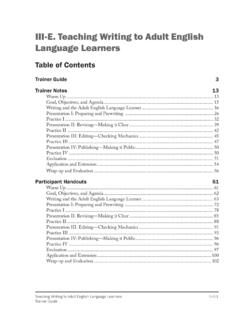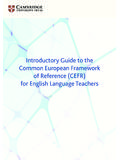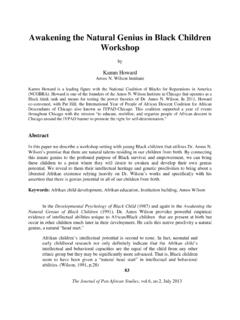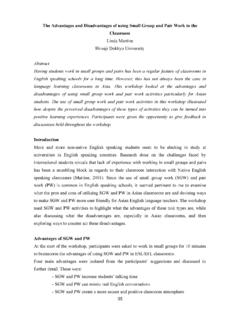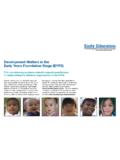Transcription of A-level Creative Writing
1 AQA Educat ion (AQA) is a r egist er ed char it y (number 1073334) and a company limit ed by guar ant ee r egist er ed in England and Wales (number 3 64 472 3 ). Our r egist er ed addr ess is AQA, Devas St r eet , Manchest er M1 5 6EX. A-level Creative Writing Teaching Resources: Approaching First Teaching A series of essays, written by the A-level Creative Writing senior examining team, offering advice and guidance on how to approach the first term of teaching Creative Writing in your school or college. This document is not intended to be a definitive how to guide but to give some ideas and suggestions that can be adapted to suit particular students and particular teaching environments. 2 THIS PAGE IS INTENTIONALLY BLANK 3 Contents Page 1.
2 Organising the First Term of Teaching 5 2. Becoming a Writer 10 3. Writerly Reading: Establishing a Programme of Reading for A-level Creative Writing 14 4. The Commentary 19 5. The Writers Workshop 23 4 THIS PAGE IS INTENTIONALLY BLANK 5 Organising the First Term of Teaching Lyn Lockwood, Chief Examiner Lyn Lockwood is an English teacher with twenty years experience in the classroom and an experienced examiner at both GCSE and A-level . She now combines teaching with studying for a Doctorate in Education at the University of Sheffield, having completed an MA in Writing at Sheffield Hallam University. Lyn is a founding member of the Sheffield Novel Writing group. Introduction This can only be a series of suggestions - you may be teaching a small number of mature students at a community centre, a class of 10 in a sixth form, or 25 in a college, you may be teaching alone, you may be teaching in a pair - you may have 5 hours a week or 2 hours a fortnight.
3 Everyone will know what is best for their particular circumstances. This is just to give you some ideas about; your expectations of students and some ground rules long term and medium term planning resources lesson planning There is more material in this booklet that offers guidance on specific areas of the course, such as the commentary Writing and the workshop structure. A word about teaching. It s not advisable to divide this course between staff by unit, along the lines of CREW1 and CREW2; both are intended to be the culmination of the workshop and journaling process and a holistic approach is essential to build the skills required. It would be expected that both teachers would follow a similar path and maybe divide teaching in terms of form, or genre. For example, one teacher may lead on poetry and another on script (although this could be quite fluent in itself).
4 The most successful approaches will be integrated and shared between teachers, with the freedom for students to explore, write, read and work towards the shared goals of both CREW1 and CREW2. First things You might want to start by establishing some ground rules with your students, because the way that this course should be approached will be distinctly different from A-levels in English. I approach the course as an expressive art, and borrow some of the structures of art and technology courses. My ground rules are; Everyone maintains a Writing journal or blog, and they commit to regularly Writing something in it; at least three times a week (even if it is only a sentence or two) Everyone commits to a regular reading habit - you should be open to reading books, journals, articles, poetry etc that may be outside your comfort zone 6 A Writing task that is attempted by all the class will be workshopped ie.
5 You will be expected to share/read out your Writing regularly at various stages of drafting. You are not expected to read out something that would make you feel really uncomfortable, but you need to start the course remembering that it is training you to work in the style of professional writers/artists. This means you assume a public audience for your work and you write accordingly. These rules should be openly debated and discussed - it is essential that the students understand their significance. They may want to add/alter, but I think the spirit of the rules should largely be maintained. I would also intervene very quickly with a student who continually refuses to read/share because they are probably not on the right path to success! You could use the analogy of an artist who refuses to let anyone look at their paintings, or visit art galleries that they are unfamiliar with, or practice drawing in a sketch book, and who works in the studio with curtains draped around their canvas so no-one can see what they are doing!
6 The CREW1 (the AS examination) and CREW2 (the AS coursework) are both designed to be a natural culmination of the acquisition of skills and knowledge acquired through regular reading and Writing practice. This is not a courses in which students can coast and then cram at the last minute. CREW1 will present candidates with a wide variety of tasks, which means confidence and flexibility are essential skills. In CREW2, two pieces of Writing should arise from work that the students have done throughout the year, and this should be a range; short stories, blogs, radio scripts, travel Writing articles etc. The idea is that the students will practice Writing in lots of different styles, but the coursework will be the full development of two pieces that they enjoyed the most and will reflect an authentic journey as a writer.
7 This authentic journey will then underpin the CREW2 reflective commentary. To return to the art analogy- art students will spend the year using oils, pastels, water colours, felt tips, photography, clay- and they will be encouraged to choose their favourite medium and style for their final pieces. Just as no A-level Art student would expect to be told they are producing a water colour painting of a church for their final piece, no Creative Writing student/class should be directed to a particular genre and type of Writing . It would also make the journaling, workshopping and drafting processes rather redundant, in which case the CREW2 commentary Writing would be virtually meaningless. So how do we manage that as teachers? Week to week ideas Encourage a varied diet of reading and Writing activities. There is guidance on this in the specification (in terms of what kind of texts students are expected to be familiar with and able to produce), but you may want to arrange this thematically or by genre.
8 You might want to consider covering the four forms (prose fiction, prose non-fiction, poetry, script) For example; a typical first six 6 week stretch might look like this; Week 1-2 travel Writing - From Our Own Correspondent radio scripts, online travel blogs eg , Robert Frost poetry 7 Week 3-4 short stories/expressive prose fiction - short stories by Jackie Kay, Tim Gatreux, Ali Smith- , Radio 4 Week 5-6 satire - In the Thick of It script (BBC), Stewart Lee How I Escaped My Certain Fate, extract from Private Eye (New Coalition Academy), , Sophie Hannah poetry You could alternate between factual and fictional Writing . In a typical week I would expect students to undertake one Writing task and one piece of research, read at least one item directed by the teacher and share at least one piece of reading or Writing with the rest of the class.
9 I would build in an hour s timed Writing once every two weeks or so, as Writing to a brief within a time limit is an essential skill to practice. Peer marking could cut down on the assessment burden for colleagues with larger groups. I would say a typical 90 minute session should contain at least two or three of the following a warm up Writing task (taking no more than 10 minutes, with prolonged staring into space thinking being banned - to be shared immediately, or returned to later - This could connect to a text you want to introduce) o HANDS' Think of someone close to you. Describe their hands. Share. Read Ted Hughes poem and discuss the challenge of descriptive Writing ) a reflection on the previous lesson s topic (What s stuck in your mind? Any further thoughts/questions) a drafting or re- Writing task (with maybe a good 15-20 minute stretch of silent Writing , which could be longer as you build up to the exam) in response to a stimulus- an extract from a film, a picture, an opening line etc.
10 O NEWSPAPER SPRINGBOARDING Give out a range of short newspaper articles about notable events- maybe a murder, a fire, bad weather - turn it in to a first person account maybe as a poem, blog or script a reading activity (either as a class, small groups, or individuals) o Collect some samples of essays that writers have written about Writing itself- from Stephen King to TS Eliot - writers like to do this. In groups, read the extract and explain what it says about Writing and to formulate arguments for and against- this could lead to Writing your own writer s manifesto in an Orwellian list, or a short reflection on what they think Writing is about. The class could collect their own quotes and maybe rank order them in terms of who they most/least agree with. 8 a presentation/reading of more drafted work o Each student could pre-arrange a performance slot of something they have been working on, with an introduction to the piece, a reading and a discussion - this is a more formal type of workshop activity.











